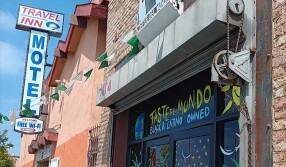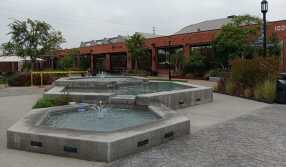Popular L.A. Food Mashups and Why We Love Them

Angelenos love food mashups. We still line up for Kogi’s beloved bulgogi burritos, while newcomer X'tiosu Kitchen’s fusion of Oaxacan and Lebanese cuisines is making waves in Boyle Heights. Yong Chen, a history professor at UC Irvine and the author of "Chop Suey USA: The Story of Chinese Food in America," believes part of fusion food's pull in L.A. is because Los Angeles (and the Southland in general) is "an important destination for immigrants." We have a culinary diversity here that makes it easy to share. However, Chen notes that every cuisine is, in some way, a kind of fusion food.
"A cuisine does not develop in isolation, but is the result of constant interaction with other culinary traditions," Chen said. He points to Peranakan or Nyonya cuisine, which is a blend of Chinese and Malay cooking styles and Cajun food, which was developed in Louisiana by Acadians — French settlers who were forced from Acadia (now Canada and parts of Maine) south by the British.

"[Fusion food's] appeal is that, by combining the merits and prominent features from more than one cuisine, it represents an exciting, new invention," Chen said. "There are so many fusion dishes [and] there are also many restaurants that make a conscious effort to offer fusion food, from Wolfgang Puck to Shiro."
Wolfgang Puck, who is sometimes credited with launching the fusion trend with restaurants like Santa Monica's Chinois on Main and the now-closed Postrio in San Francisco, is still doing it in his restaurants. According to Chef de Cuisine John Lechleidner at downtown Los Angeles' WP24, they're currently serving an Apple Tarte Tatin with toasted sesame ice cream and miso butterscotch, "flavors that unexpectedly complement each other very well and allow guests to reimagine a traditional French dessert with Asian ingredients.”
We sought out five purveyors of food mashups and asked them how their cultural influences inspired these dishes, and why they think L.A. is the mashup champion.
Middle Eastern Baby Back Ribs
Restaurateur George Abou-Daoud has two Middle Eastern establishments in his collection: Bowery Bungalow in Silver Lake, and Farida in Hollywood. This cuisine is close to home for Abou-Daoud: his mother hailed from Beirut, while his father grew up in Cairo.
Abou-Daoud had observed that many Middle Eastern restaurants, though they may vary by region, offer the same menu from city to city. So, he chose to add a modern, California twist, inventing several new dishes that combine Middle Eastern flavors with other cultural cooking styles. Hence, Bowery Bungalow’s Middle Eastern Baby Back Ribs.

"There's no such thing as baby back ribs in the Middle East, number one, and number two, there's really no such thing as a pork product in the Middle East," he said. "I thought, what would it taste like if there was?"
They dry-rub the ribs with Middle Eastern spices and smoke them on-site until they're tender. When someone orders them, they're cooked in a wok with grape molasses and Middle Eastern coffee.
"It's a completely made-up dish, but it brings you the flavors of the Middle East in an American dish, and then on top of that, it's cooked in a Chinese wok," he said.
The restaurant also offers fried rice made with turmeric, chicken, almonds and golden raisins. Essentially, Abou-Daoud says, they take the ingredients someone in the Middle East might use to stuff a chicken and turn it into a dish cooked in an Asian style.
"I think [food mashups] are popular in every major city, and that's because we've come accustomed to what's typical and people want to vary beyond that," he said. "It's not like a new country is going to be formed with a new cuisine that's this revolutionary thing ... This is how we obtain new flavors. When people create new dishes, it evolves the cuisine."
Korean Tapas
Chef Matthew Ignacio recently launched Sapor Restaurant and Bar in Koreatown. Guests will find Spanish tapas and craft cocktails, plus several dishes that infuse Korean flavors as “a respectful place to the community surrounding us,” Ignacio said. They serve pork belly and galbi, but instead of offering the massive plates of their AYCE neighbors, it comes delicately plated like tapas. Their Korean-inspired fried chicken is particularly popular, served with a garlic glaze, beet romesco, chive oil and radishes. Ignacio enjoys the concept of tapas, as it encourages people to be adventurous and try multiple dishes in one outing.
"The blending of cuisines in Los Angeles works so well because of the melting pot of cultures that reside here," Ignacio said. "Within five miles of Koreatown, you can metaphorically eat around the world. I think we are finally at a place where fusion is no longer 'confusion.'”

Japanese Cuisine Meets French Cooking
Hinoki & The Bird Chef Brandon Kida offers a menu that takes inspiration from his Japanese heritage and combines it with French technique.
"I am a son of a fourth-generation Japanese-American mother and a first-generation father from Japan, and I grew up in Koreatown," he said. "The cuisine I cook at Hinoki is a culmination of all these factors."
Koreatown, like many neighborhoods in Los Angeles, is "a very ethnic neighborhood," Kida said. It's these neighborhoods throughout Los Angeles that give Angelenos a chance to become comfortable with a variety of flavors. "Each neighborhood does a fantastic job representing their culture through food," he said.
A favorite dish at Hinoki & The Bird, Kida said, is a local halibut sashimi, which is served on five separate spoons. "Each spoon is garnished with seasonal ingredients, such as pickled persimmon and barred-aged tamari, which demonstrates traditional Japanese cuisine with California-centric ingredients."

Street Corn Polenta and Al Pastor Green Beans
Chef Sydney Hunter III has just become the executive chef at Testa DTLA but has been cooking for 16 years, with past stints at Kettle Black, Petit Trois and Superba Snack Bar. He grew up in the San Gabriel Valley where he was exposed to Latin and Asian cuisines, as well as mashups of the two. As a child, he was inspired by his Mexican grandmother’s cooking, from her moles (a specialty of hers) to her sense of hospitality. “She was good at giving everything that a person needs when they’re a guest, without them everything having to ask for anything, which inspired me to take care of people in that manner,” Hunter said.
Hunter combines those influences with the French and Italian techniques he’s utilized at other restaurants. He blends the flavors of al pastor into a spicy green bean dish with grilled pineapples, and offers a street corn-inspired polenta, made with parmesan cheese, roasted corn and mayonnaise infused with pepper, smoked paprika and cayenne.
“We’re all familiar with these flavors that are being put in fusion [dishes], and I think that if you can do it right, it makes sense,” he said. “People are being creative and pushing a complex flavor profile that people are familiar with and reinventing it into something else — like green beans al pastor.”

More From The Migrant Kitchen
Los Angeles Fried Rice
Sommelier Coly Den Haan (former owner of The Must, current owner of woman-forward wine shop Vinovore) and Dean Harada opened up their restaurant, Hot Hot Food, in Virgil Village this past spring. A key menu item is their L.A. Fried Rice, which contains all the fixings one might find on a street dog — pickled onions and jalapeños, plus avocado, salsa verde and a fried egg. Harada said the idea came to Den Haan in a dream when she was running The Must, ultimately becoming the cornerstone of Hot Hot Food.
The menu offers several variations of the dish, each one inspired by a different cuisine. Their Pork Fried Rice has carnitas, either pork or jackfruit, while a Chili'N Rice comes with beef brisket and hominy chili. For Harada, the Aloha Fried Rice — topped with a burger patty and gravy — is closest to home. Harada grew up eating Loco Moco in Hawaii, a dish where white rice is served with a burger, gravy and an egg.
"It's something on our menu that reminds me where I'm from, and says something about my own history," he said. "It's also sharing it in a way. It's not that I want to appeal to Hawaiians; it's that I love this [dish], and I want to share it with other people, and I want them to love it, too."
Harada thinks these kind of mashups thrive in Los Angeles in a special way, perhaps due to the city's car culture, where a drive down Pico from Santa Monica to downtown means drifting through numerous diverse neighborhoods and observing signs in multiple languages, often side-by-side. Additionally, he said, it's an entertainment-driven city where people are inclined to reinvent themselves on a regular basis. Perhaps that lends to the idea that we can reinvent our cuisines as well.
"You don't get Chinese-Food-Slash-Donut-Shops across the country," he said. "Those things, to see them on a day-to-day basis, reminds me of what it's like to be an Angeleno."

Top image: Green Bean Al Pastor | Jakob Layman













